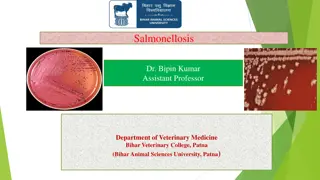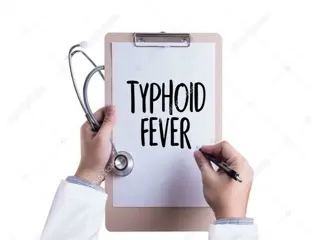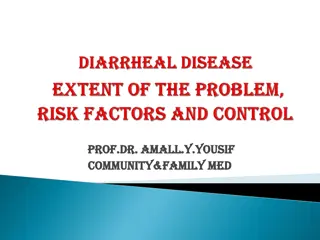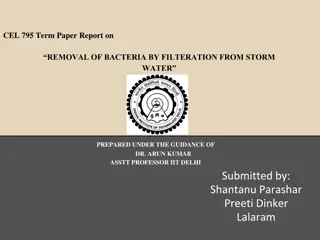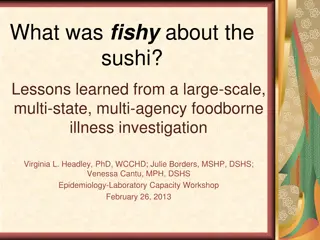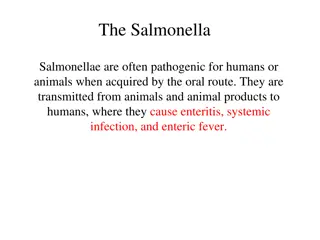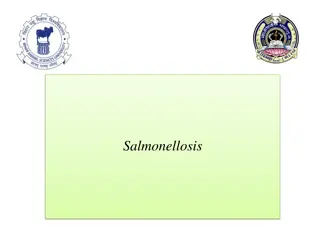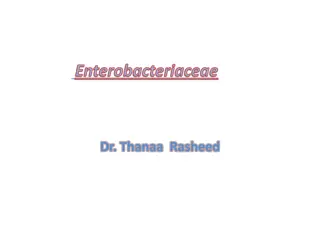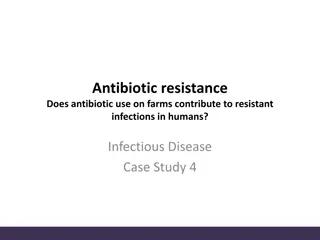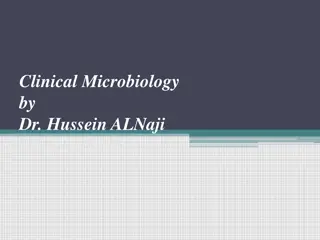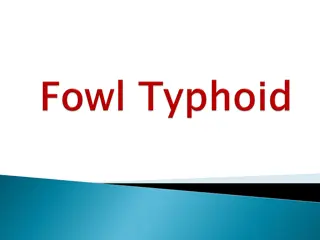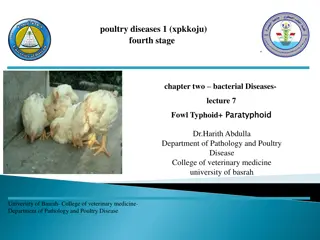
Understanding Salmonella Infections: Characteristics and Transmission
Learn about the characteristics of Gram-negative facultative anaerobic bacilli - Salmonella, including their habitat, species, serotypes, and virulence factors. Discover how Salmonella causes diseases like gastroenteritis and typhoid fever, and how it spreads through contaminated water, food, and milk.
Download Presentation

Please find below an Image/Link to download the presentation.
The content on the website is provided AS IS for your information and personal use only. It may not be sold, licensed, or shared on other websites without obtaining consent from the author. If you encounter any issues during the download, it is possible that the publisher has removed the file from their server.
You are allowed to download the files provided on this website for personal or commercial use, subject to the condition that they are used lawfully. All files are the property of their respective owners.
The content on the website is provided AS IS for your information and personal use only. It may not be sold, licensed, or shared on other websites without obtaining consent from the author.
E N D
Presentation Transcript
Gram negative facultative anaerobic bacilli Non lactose fermenting colonies highest during the rainy season in tropical climates and during the warmer months in temperate climates.
Has two species S.enterica (six subspecies I, II, III, IV, V, VI) S.borgori (rare) Cold blooded animal, birds, rodents, turtles, snake and fish
NO. OF SEROTYPES WITHIN SUBSPECIES 1504 SALMONELLA SPECIES AND SUBSPECIES USUAL HABITAT S. entericasubsp. enterica(I) Warm-blooded animals Cold-blooded animals and the environment* Cold-blooded animals and the environment* Cold-blooded animals and the environment* Cold-blooded animals and the environment* Cold-blooded animals and the environment* Cold-blooded animals and the environment* S. entericasubsp. salmae(II) 502 S. entericasubsp. arizonae (IIIa) 95 S. entericasubsp. diarizonae (IIIb) 333 S. entericasubsp. houtenae (IV) 72 S. entericasubsp. indica(VI) 13 S. bongori (V) 22 Total 2541
Fimbria - Adherence Endocytosis SPI 1 T3SS TLR Replication in microphage Enterotoxin
O. somatic antigen H. Flagellar antigen K. capsular antigen
VIin Salmonella serotype typhi (virulence heat-labile capsular homopolymer of N-acetyl- galactosamino-uronic acid) vs phagocytosis O Antigen (Heat stable) is lipopolysaccharide in the outer membrane A,B,C1,C2,D,E H-antigen (Heat labile)
Acute gastroenteritis Typhoid fever Nontyphoidal bacteremia Carrier state following Salmonella infection
Water food and milk contaminated with human or animal excreta Salmonella typhi and S. paratyphi the source is human
Food poisoning through contaminated food S. enterica subsp. enterica Source poultry, milk, egg & egg products and handling pets Infective dose 106bacteria IP 8 36 hrs. fever, chills, watery diarrhea and abdominal pain, self limiting In sickle cell, hemolytic disorder and ulcerative colitis, elderly or very young patient the infection may be very severe. At high risk for dissemination & antimicrobial indicated
Prolonged fever Bacteremia Involvement of the reticulo endothelial system (liver, spleen, intestines and mesentery) Dissemination to multiple organs Ingestion of contaminated food by infected or carrier individual By salmonella serotype typhi or S. paratyphi A, B and C (less severe) Tropical ,subtropical, Traveler (sewage, poor sanitation) IP : 9 14 days.
First week First week fever, malaise, anorexia, myalgia and a continuous dull frontal headache then, Patient develops constipation Mesenteric lymph node blood stream liver, spleen and bone marrow Engulfment of salmonella by mononuclear phagocytes (multiply intercellularly) Released into the blood stream again that can lead to high fever (blood culture positive)
2 2nd Sustain fever prolonged bacteremia Invade gallbladder and payer's patches Rose spots 2ndweek of fever Billiary tract GIT Organism isolated from stool in large number ndand and 3 3rd rdweek week
Ceftriaxone Ciprofloxacin Trimelhoprim Sulfamethoxazole Ampicillin Azithromycin or Ceftriaxone from patients from India and SE Asia due to resistance of strains. and Ciprofloxacin from patients from other areas. Salmonella gastroenteritis uncomplicated cases require fluid and electrolyte replacement only.
Necrotizing cholecystitis Bowel hemorrhage and perforation Pneumonia and thrombophlebitis Meningitis, osteomyelitis, endocarditis and abscesses.
S.sonnei (group D1) most predominant in USA ( fever, watery diarrhea) S.flexneri (group B15) 2ndmost common Young adult ( man who have sex with man) S. dysenteriae (group A 6 )and S. boydii (group C 20) are most common isolates in developing countries S. dysenteriae type 1 associated with morbidity and mortality. Human is the only reservoir
Cause bacillary dysentery ( blood, mucus and pus in the stool) Non lactose fermenter
Has 4 species and 4 major O antigen groups All have O antigens some serotype has K antigen ( heat labile removed by boiling) Shigella are non motile, lack H antigen
Person to person through fecal oral route Flies, fingers Food and water Young children in daycare, people in crowded area and anal oral sex in developed countries Low infective dose < 200 bacilli Penetrate epithelial cells leads to local inflammation, shedding of intestinal lining and ulcer formation
High fever, chill, abdominal cramp and pain accompanied by tenesmus of bloody stool with mucus & WBC IP 24 - 48 hrs Can lead to rectal prolapsed in children Complication ileus, obstruction dilatation and toxic mega colon Bacteremia in 4 % of severely ill patient Seizures, HUS
Stool culture on selective selenite enrichment broth media MAC, SS and XLD,HEA BS Sero-grouping based on O and H antigen Sereny test 1.
Antibiotic s used to reduce duration of illness ampicillin , oral TMP-SMX or ciprofloxacin or doxycycline. IV ceftriaxone and

